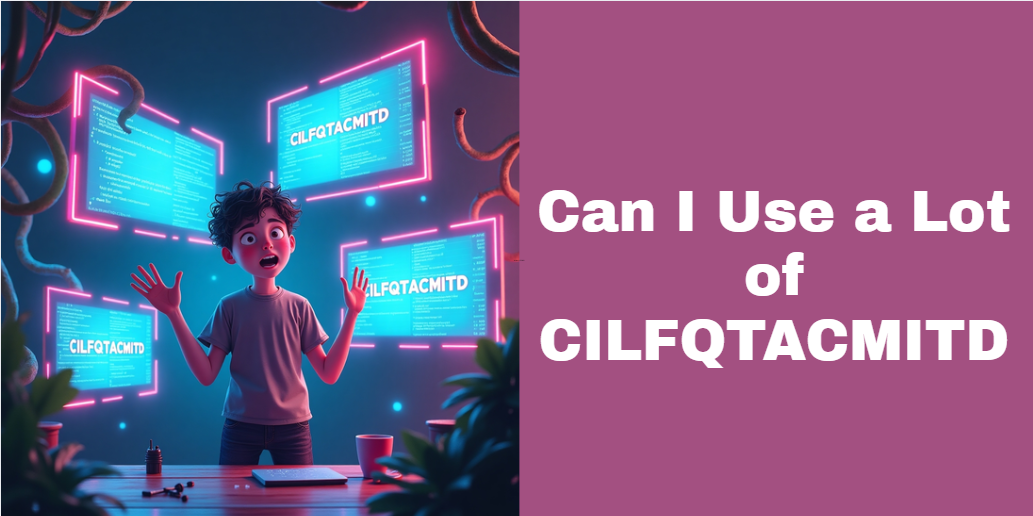Can I Use a Lot of CILFQTACMITD? A Comprehensive, Easy-to-Understand Guide
Introduction
The phrase “can I use a lot of CILFQTACMITD” may sound cryptic at first glance, but it has stirred curiosity online—especially among tech enthusiasts, developers, and creative thinkers. While the acronym CILFQTACMITD doesn’t refer to any officially recognized framework or software tool, it has gained attention as a mysterious yet intriguing term. Whether it’s a placeholder, an imaginative concept, or part of an internal project, this guide aims to explore everything about it in a reader-friendly and detailed way.
This article serves anyone who has seen the term “CILFQTACMITD” in a forum, document, or even a meme—and wants to understand whether they can actually use it extensively, safely, and effectively.
What Is CILFQTACMITD?
At its core, CILFQTACMITD is a made-up acronym that has no documented origin in mainstream tech repositories or programming libraries. Some speculate that it stands for: “Can I Live Freely and Quickly While Tackling All Challenges Manually In The Day”. Others believe it’s simply a creative string used in a fictional or prototype setting. Still, a small subset of tech hobbyists playfully refers to it as a flexible automation routine or a pseudo-framework.
Despite its lack of formal definition, CILFQTACMITD has become a conceptual placeholder for powerful, customizable routines—especially those imagined to streamline complex workflows or testing environments.
Why Ask “Can I Use a Lot of CILFQTACMITD”?
The key question—“can I use a lot of CILFQTACMITD”—implies whether this idea or tool (if it exists) is safe, beneficial, or scalable. Many users ask similar questions when working with unfamiliar scripts, new plugins, or even internal code generators.
There are a few reasons why this phrase might be circulating:
- Conceptual Use – People are testing the waters with made-up but logically structured routines.
- Debugging Contexts – Developers might use the phrase as filler for automation trials.
- Curiosity & Humor – It could stem from a joke or meme, later explored seriously.
Potential Features & Hypothetical Benefits
Although CILFQTACMITD is not a concrete tool, if we treat it as a hypothetical automation framework, it might offer these speculative advantages:
| Feature | Description |
|---|---|
| Automation | Runs repeated tasks across platforms |
| Customization | Adaptable to user-specific scripts or workflows |
| Integration | Imaginary compatibility with CI/CD pipelines |
| Manual Control | Offers more human logic than AI automation |
If these qualities were real, then yes—you could use a lot of CILFQTACMITD, especially in testing environments or innovation labs.
Is It Safe to Use a Lot of CILFQTACMITD?
When discussing whether you can use a lot of CILFQTACMITD safely, the answer depends on your context. Since it’s not tied to a real-world tool, its use is purely hypothetical and won’t interfere with operating systems or other software.
However, if used as a metaphor for pushing manual logic into a structured workflow (as the acronym suggests), then excessive use might lead to bottlenecks in scalability, especially without automation.
Here are some safety checkpoints to consider:
- Avoid Overuse in Production: If using the term to describe repeated manual routines, shift toward automation for efficiency.
- Sandbox First: Always experiment in a test environment before full rollout.
- Track Results: Keep logs to monitor what your “CILFQTACMITD” components are affecting.
How to Safely Implement It
If you’re playfully or symbolically implementing “a lot of CILFQTACMITD” into a project, here’s how to do it effectively:
- Start Small: Create a basic shell or Python script labeled with the acronym. Use it as a metaphor for testing new logic flows.
- Document Everything: Even if it’s not real software, documenting your usage helps trace logic and share insights.
- Create Aliases or Functions: In command-line environments like Bash or PowerShell, alias your experimental script names as
cilfqtacmitd_run, etc.
In fictional development, people often use placeholders before switching to real tools. So this could serve as an ideation starter before replacing it with real code.
Alternatives to CILFQTACMITD
For those who love the idea of “using a lot of CILFQTACMITD,” here are real tools that offer similar functionality:
| Tool | Use-Case | Platform |
|---|---|---|
| Bash Scripts | Automation via terminal | Linux, macOS |
| Jenkins | CI/CD Pipelines | Cross-platform |
| Python + Cron | Scheduled task automation | Linux/macOS |
| GitHub Actions | CI workflows | GitHub repos |
You may enjoy using these tools if the philosophy of CILFQTACMITD aligns with your interest in flexible, customizable automation.
Real‑World Examples (Conceptual)
Even though there are no real implementations of CILFQTACMITD, here’s how it might theoretically be used:
- Developer Prototyping: A developer uses
cilfqtacmitd.shto batch-test different CLI configurations before deploying real code. - Testing Workflow Ideas: Someone sets up a GitHub repo labeled “CILFQTACMITD” to prototype flexible workflow engines.
- Learning Purpose: New coders invent acronyms like CILFQTACMITD to break down complex routines into manageable ideas.
In these fictional cases, the keyword can I use a lot of CILFQTACMITD fits perfectly—it expresses curiosity, experimentation, and conceptual safety.
Ethical Considerations
Though fictional, if we explore CILFQTACMITD as a framework for human-managed tasks, ethical concerns could emerge:
- Over-Reliance on Manual Control: Human-driven processes might reduce efficiency.
- No Accountability Layer: Unlike certified software, a conceptual tool like CILFQTACMITD lacks traceability.
- Naming Clarity: Using undefined acronyms may confuse teams or future collaborators.
If you’re developing under this placeholder concept, it’s wise to clearly define terms, and avoid misleading other team members.
Future Outlook
The future of CILFQTACMITD—as a phrase or concept—depends on whether the developer community embraces it symbolically or ironically. It’s entirely possible that:
- It evolves into a code-naming convention.
- Gets replaced by real tools or frameworks.
- Becomes a meme representing human-versus-machine workflows.
Whatever the outcome, its current popularity suggests people love thinking about automation, freedom, and customization—even if the acronym is playful.
Conclusion
To answer the question once and for all—can I use a lot of CILFQTACMITD? Absolutely—especially if you’re using it as a symbolic representation of flexible, manual, or prototype-level workflows. There’s no danger, no real-world software collision, and total creative freedom.
In fact, using CILFQTACMITD might encourage developers and learners to think critically about how they manage tasks, automate routines, or build systems from scratch. So go ahead, use it in moderation or excess—just make sure you define what it means in your environment.
If you’ve come this far, you probably care about both clarity and innovation. So don’t stop here—keep asking questions, testing ideas, and who knows—maybe you’ll define what CILFQTACMITD really means for future developers.
More Posts
Fiannaças: Exploring the Dual Nature of Financial Power and Cultural Heritage
2020 RYC-40HS Shipping Container: Everything You Need to Know
The Full Story of Susanne Capurso at 302 Spring Drive, East Meadow
Does Medicaid Pay For Resmetirom Tablet In Nevada? Full Coverage Breakdown






